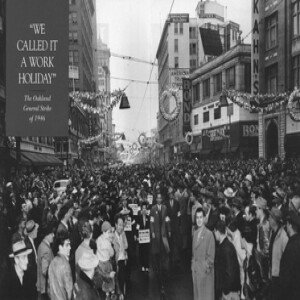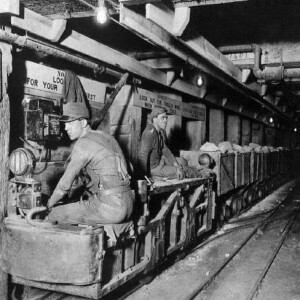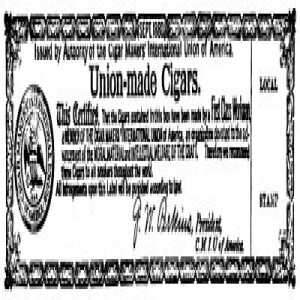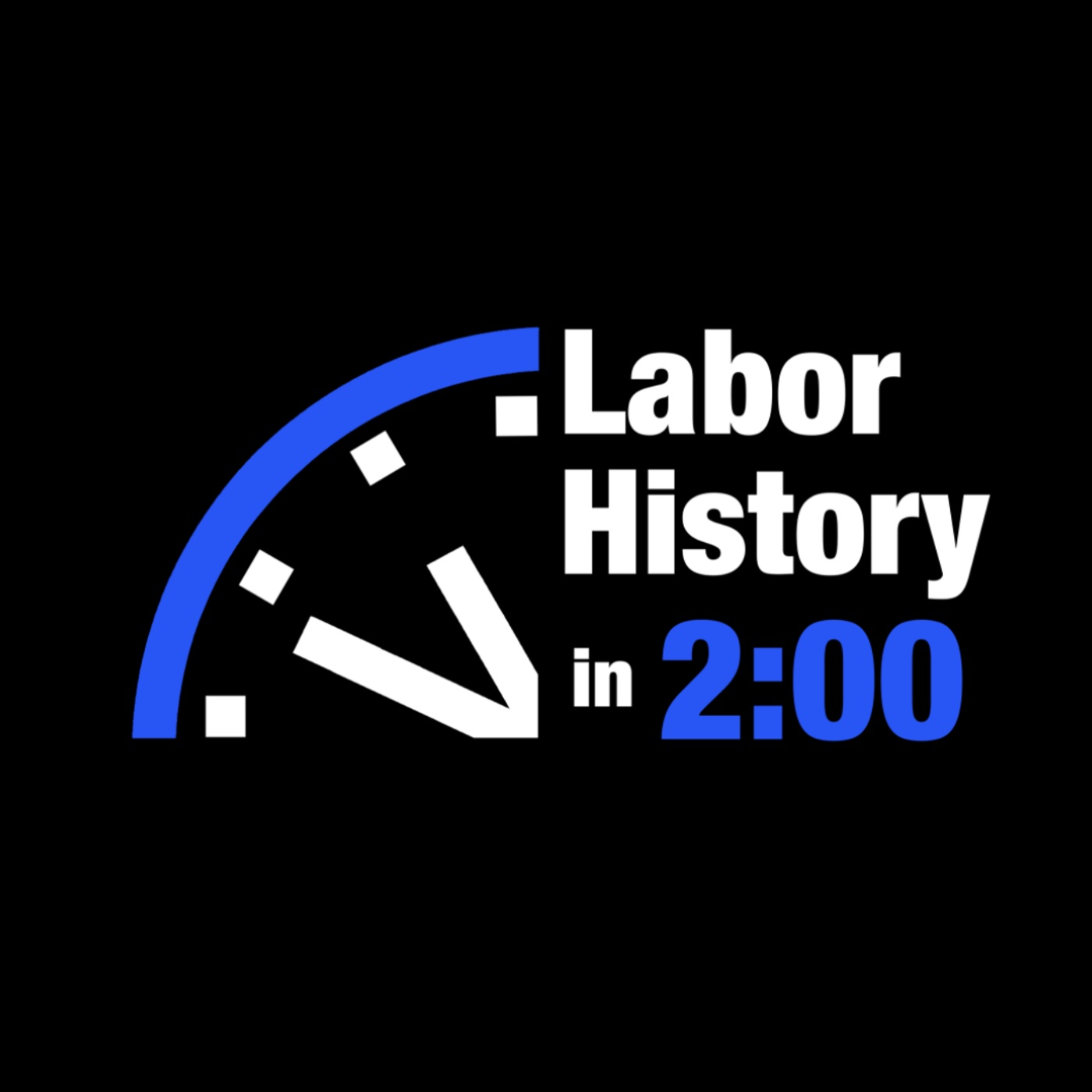Episodes

Tuesday Dec 03, 2024
December 3 - The 1946 Oakland General Strike
Tuesday Dec 03, 2024
Tuesday Dec 03, 2024
On this day in labor history, the year was 1946. That was the day a general strike erupted in Oakland, California.
Workers, mostly women, had been on strike for a month at two downtown department stores.
Teamsters honored their picket lines and refused to make deliveries. Infuriated owners of Hastings and Kahn’s demanded their merchandise and turned to the city for help.
On this day, police assembled early in the morning to clear the streets of picketers. They attacked strikers, forced them off the streets and set up a perimeter of machine guns to escort scab delivery trucks through.
One striker recalled, “I was black and blue for six months from their clubs.” Outraged truck drivers, bus drivers and streetcar operators all stopped, got out of their vehicles and joined the strikers, quickly filling downtown Oakland.
By the end of the day, the city was completely shut down. 142 AFL unions called for a labor holiday in support of the strikers and now 130,000 workers were on strike in solidarity.
UAW member Stan Weir recalled that it was the bus drivers, many just returned from the war, who led the strike. The streets that night had a carnival like atmosphere. War vets led a march to City Hall to demand the resignation of the Mayor and the City Council for their attempts to break the strike.
The general strike quickly forced the administration to stop the scabhearding. But local labor leaders were divided over what some considered a near insurrection and called the strike off 54 hours later.
The retail workers were left to fight on their own for another five months. But for a few days, workers got a taste of their own power.

Monday Dec 02, 2024
December 2 - John Brown Hanged
Monday Dec 02, 2024
Monday Dec 02, 2024
On this day in labor history, the year was 1859.
That was the day John Brown was hanged in Charles Town, Virginia in what is now West Virginia.
He had been sentenced to death on charges of treason, murder and insurrection for his role in the raid on the United States Federal Armory at Harper’s Ferry.
Brown and twenty-one abolitionists intended to seize the arsenal there, then build a free settlement in the Appalachian Mountains.
From there, abolitionists and free people of color would wage a guerrilla war against the slave labor system throughout the South.
Convicted on November 2, Brown resisted plans for rescue and prepared to die a martyr.
On this day, John Brown wrote his last statement: “I, John Brown, am now quite certain that the crimes of this guilty land will never be purged away but with blood. I had, as I now think, vainly flattered myself that without very much bloodshed, it might be done.”
He was marched out of the Jefferson County Jail through a crowd of onlookers that included Stonewall Jackson and John Wilkes Booth to the gallows, where he was hanged.
While many abolitionists distanced themselves from his actions, they defended him and memorialized him after his death.
Fredrick Douglass remarked many years later, “His zeal in the cause of my race was far greater than mine-it was as the burning sun to my taper light-mine was bounded by time, his stretched away to the boundless shores of eternity. I could live for the slave, but he could die for him.”

Sunday Dec 01, 2024
December 1 - Exploitation in the Mines
Sunday Dec 01, 2024
Sunday Dec 01, 2024
On this day in labor history, the year was 1912. That was the day the Anaconda Copper Company instituted its rustling card system at its copper mines in Butte, Montana.
The company used the rustling card in two ways: as a work permit and as way to keep track of miners. A miner looking for work would first have to apply for a card. Miners had to present information about citizenship status, English literacy skills, work history and two years of employer references. Once the card was approved, the miner would then be allowed to apply for work.
The Butte Miners’ Union charged it was the company’s way of blacklisting those who had quit, been fired or known as a union militant. By 1917, the Metal Mine Workers Union and the IWW added that the company was looking to “nip agitation in the bud.” They alleged employers were holding on to cards or denying them altogether for no reason.
According to historian Paul Brissenden, both unions maintained the company was looking “to punish those who were at one time active in the socialist administration of Butte Mayor Lewis J. Duncan, to prevent the Socialist Party from again securing a foothold in Butte, to strengthen the hands of the more conservative unions and to curb the industrial unionism of the IWW and Metal Mine Workers Union.” The company asserted its right to keep its enemies out of the mines, alleging they presented a danger to mine safety.
But the unions shot back, stating the blacklist meant the hiring of untrained, inexperienced workers who presented the real danger. Brissenden notes that many union radicals continued to work in the mines despite the card system.

Saturday Nov 30, 2024
November 30 - The World Loses the Miners’ Angel
Saturday Nov 30, 2024
Saturday Nov 30, 2024
On this day in labor history, the year was 1930. That was the day the world lost the miners’ angel, Mother Jones. She had crossed the country many times over, been involved in practically every strike that built the labor movement; stood with miners and steel workers and mill children everywhere. Mother Jones had asked to be buried with the Virden Martyrs, killed in the Massacre of 1898, at Union Miners Cemetery in Mt. Olive, Illinois. Dozens of labor leaders including AFL president William Green, attended her funeral in Maryland, where she had been living. Then, AFL representatives, several Illinois miners and others boarded the Baltimore and Ohio train to accompany her body to Mt. Olive. Historian Dale Fetherling describes the scene as her body arrived. A band played “Nearer, My God, To Thee” as onlookers bowed their heads and wept. Survivors of the Virden Riot bore the casket to the Odd Fellows’ Hall where it lay in state… The town of 3,500 with its strong and violent heritage, was thronged by thousands of coal diggers.” At least 15,000 turned out for the funeral, broadcast on WCFL, the Chicago Federation of Labor’s radio station. The labor priest, Reverend John Maguire gave the memorial address and officiated at the funeral in Mt. Olive’s Roman Catholic Church of the Ascension. He asked: “What weapons had she to fight the fight against oppression of working men? Only a great and burning conviction that oppression must end. Only an eloquent and flaming tongue that won men to her cause. Only a mother’s heart torn by the suffering of the poor. Only a towering courage that made her carry on in the face of insuperable odds. Only a consuming love for the poor.”

Friday Nov 29, 2024
November 29 - A Deadly Dust in the Air
Friday Nov 29, 2024
Friday Nov 29, 2024
On this day in labor history, the year was 1937. That was the day the National Labor Relations Board began hearings on an unfair labor practice brought by the International Union Mine, Mill and Smelters. Mine, Mill had been fighting the union busting tactics at Eagle-Picher Lead Company. The union had been organizing lead and zinc miners in the Tri-State area of Kansas, Missouri and Oklahoma. During the Great Depression, they built the union by emphasizing safer working conditions, stressing the hazards of silicosis and tuberculosis. In their book, Deadly Dust: Silicosis and the Politics of Occupational Disease, Gerald Markowitz and David Rosmer note that one of Mine Mill’s demands included the elimination of the company clinic. They argued it was used to target and fire diseased workers, rather than provide a safe work environment. Mine Mill also organized other area industries, to counteract the near total power of the mine owners in the region. When the union called a strike at area mines in May 1935, the area’s largest producer, Eagle Picher Lead moved quickly to force a lockout and establish a company union. During the hearings, the union was limited in its ability to raise health and safety issues. They did win reinstatement and back pay for workers fired during the strike. But the case brought national attention to silicosis in the Tri-State area. In a letter to Francis Perkins the following year, the head of the Cherokee County Central Labor Body hoped to secure legislation to compel the companies to install ventilation systems and safety devices. He noted the average life of a miner was 7-10 years, with many dying in 2 or 3 years. But a federal standard on silica was still decades away.

Thursday Nov 28, 2024
November 28 - Stop the Presses! Workers Demand a Living Wage!
Thursday Nov 28, 2024
Thursday Nov 28, 2024
On this day in labor history, the year was 1953. That was the day 400 photo-engravers at six New York City newspapers walked off the job. Members of the AFL’s International Photo-Engravers Union had just voted down arbitration. All but one local newspaper, The New York Herald Tribune were idled as 20,000 newspaper workers refused to cross the engravers picket lines. Six days into the strike, that newspaper suspended operations as well. Writers at The New Yorker magazine remarked they were “curled up with the Wall Street Journal, The Daily Worker and a two-day old copy of La Prense.” In the decades before digital images, photoengraving was a labor-intensive process. Highly skilled workers made metal plates from which newspaper images were printed. Photo-Engravers had been working without a contract since the end of October. They demanded a $15 a week raise. The Newspapers Association was only willing to grant $3.75. The other newspaper unions had been offered similar wage and benefit packages, far below their demands. They knew that whatever they won or lost depended on the victory of the Photo-Engravers strike. So they walked out in solidarity. Federal mediators intervened in an attempt to settle the strike. Hysteric newspaper editors across the country shrieked that the union had accomplished what the government would never dare to do: subvert the freedom of the press! They sulked that the strike had broken 35 years of industrial harmony and peace; adding that the ungrateful workers didn’t appreciate just how good they had it. After eleven days, members voted to end the walkout and let a fact-finding board solve the dispute. Three months later, that board upheld the Newspaper’s Association original offer of $3.75 a week plus benefits.

Wednesday Nov 27, 2024
November 27 - Sitting Down at Midland Steel
Wednesday Nov 27, 2024
Wednesday Nov 27, 2024
On this day in labor history, the year was 1936. That was the day 1200 production workers at Detroit’s Midland Steel sat-down for higher wages, an end to piecework and union recognition.
The strike was called just before noon. When 800 on the second shift arrived for work, they readily handed their lunches, cigarettes and newspapers through the windows to the sit-downers.
The UAW had embarked on a massive organizing drive throughout the country. Days earlier, the GM sit-down strike had begun in Atlanta, spread to Kansas City and would eventually reach Flint, Michigan. But the UAW was also organizing parts suppliers like Midland, who produced car body frames for the industry.
The UAW first used the tactic of the sit-down strike ten days earlier at the Bendix Products brake plant in South Bend, Indiana. There, workers had just organized with the UAW. They braved eight days in an unheated factory during winter, demanding the company union be dismantled.
At Midland, workers stayed in the plant, stating they would hold out till Christmas if they had to. Within a week, the Midland strike had idled 72,000 workers at Chrysler, Plymouth, Dodge, Desoto, Briggs and Ford’s Lincoln-Zephyr plants. Stakes were so high at Midland that strikers threw a suspected company spy out a second story plant window.
Just as Midland workers returned victorious to their job ten days later, thousands of others began sitting down at their jobs. Rubber workers in Akron, glass workers in Ottawa, Illinois, bus drivers in Flint, Kelsey Hayes brake workers and aluminum workers just two blocks from Midland were all sitting down for union recognition, wage increases and better working conditions. The massive strike wave had begun.

Tuesday Nov 26, 2024
November 26 - Revolutionizing the Rails
Tuesday Nov 26, 2024
Tuesday Nov 26, 2024
On this day in Labor History the year was 1867. That was the day that J.B. Sutherland of Detroit patented the first specialized refrigerated railroad car. Southerland’s design included ice tanks at both ends of the car and ventilation flaps on the floor, which used gravity to send a draft of cold air flowing throughout the car.

Monday Nov 25, 2024
November 25 - Strike for Better Schools
Monday Nov 25, 2024
Monday Nov 25, 2024
On this day in Labor History the year was 1946. That was the day that teachers in St. Paul, Minnesota went on strike. It was the first ever organized walkout of teachers in the United States. The strike was organized by the St. Paul Federation of Teachers Local 28.

Sunday Nov 24, 2024
November 24 - Cigar Makers Organize
Sunday Nov 24, 2024
Sunday Nov 24, 2024
On this day in Labor History the year was 1875. That was the day that Samuel Gompers founded the Cigar Makers’ International Union Local 144 in New York City. The very first Cigar Marker’s Union local had been established in Baltimore in 1851 by craftsmen who opposed importation of lower-paid laborers from Germany.

